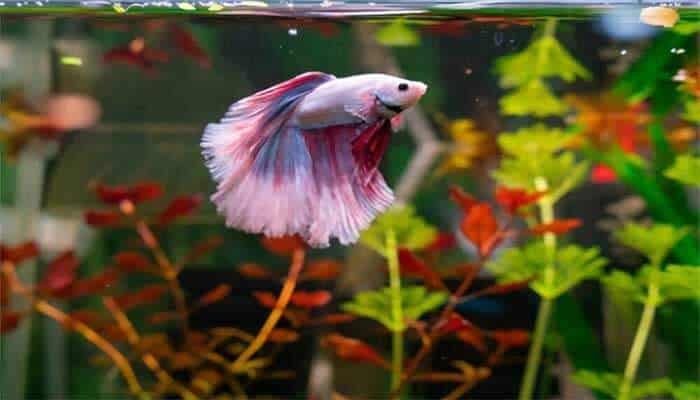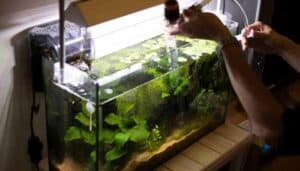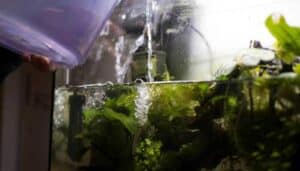Are you wondering about how to change betta fish tank water of yours? Don’t worry; this article is to help you to step by step how you can change your betta fish tank water correctly.
You’ll also learn about which is the best water for a betta? What is the right temperature for betta? How often should you change your betta tank’s water? Can you use tap water for the betta tank? And, which temperature can cause harm to your betta? Etc.
Now, let’s hop into the details: how to change betta fish water-
How to Change Betta Fish Tank Water?
First of all, decide what type of water change you will perform. There are two types of water change you can go for-
- Partial Water Change
- Full Water Change
Method-1. Partial Water Change:
Partial water change of your aquarium is always advisable. Since the full water change, may take some time to balance the water condition as the fish used to. From 10% to 50% of water change is best for a running aquarium.
It’s best to change less than 50% if the water isn’t plagued with algae or get highly toxic.
How to Do Partial Water Change Betta?
For performing a partial water change in a betta tank, you’ll need the below items:
To do a partial water change for the betta, you have to follow these steps:
1st Step- Make Ready the New Water:
As you’re planning for a partial water change for your betta tank, you need to prepare the new water first. Without getting ready of fresh water, you shouldn’t start the cleaning or changing procedure.
Take some fresh water (the amount of water you will remove from the fish tank) at a normal temperature. There’s some confusion about which water can be used in a fish tank. Let’s talk about that first-
Can I Use Tap Water for Betta Fish?
Yes, you can. Normally, using the tap water for your fish tank is popular and recommended too. But it has to meet the water condition required for the fish. The main concern is the pH level of the water. pH level can be 0 to 14, and 7 being the normal.
pH level for betta fish:
7.0 pH is called neutral, and the betta fish will thrive around 7.0 pH level. Maximum tap water pH level range from 6.5 to 7.5, which is fine for betta fish. So, using tap water for the betta tank is fine and ok.
Can I Use Distilled Water for Betta Fish? Or, Purified Water for Betta Fish?
Purified or distilled water varied from the regular tap water. Distilled or purified water has been processed and removed all the nutrients, minerals, and chemicals; therefore, they become only pure water, which won’t do any good for the betta. Hence you shouldn’t use distilled or purified water for a betta tank.
That being said, using pure water (inadequate of minerals and nutrients) for betta can cause energy lacking, dull-looking appearance, and even it may cause the death of your betta.
Can I Use Bottled Drinking Water for Betta Fish?
Bottled spring water didn’t process to remove all the essential minerals and nutrients, so it’s safe and acceptable to use in your betta tank, as long as the pH level is ok. Also, the spring water doesn’t have chlorine. However, the spring bottled water is a little bit expensive.
Then, add water conditioner with the water for betta fish. Remember to use the water conditioner from a well-known brand.
How Much Water Conditioner Per Gallon for Betta Tank?
In general, 1 milliliter = 20 drops; therefore, if the conditioner stated to use 1 ml. for 20 gallons of water, you should use 1 drop of conditioner for every gallon of water. Assuming (that) you have a smaller tank, use an eyedropper for a smaller dose, and better accuracy.
But, the amount of water conditioner per gallon varies from brand to brand. Every conditioner has written and clear instructions on the body and how much water conditioner needs to be used per gallon of water. So, follow the mentioned guidelines properly.
Why should I Use Water Conditioner?
Water conditioners remove chlorine and other detrimental elements from the water, which may cause a health issue for your fish.
Now, let the water temperature to settle. You can use a warming or cooling process to meet the betta fish temperature. Betta needs warmer water to thrive. 78° to 80° Fahrenheit is the optimal or best water temperature for betta fish, and your betta tank water temperature should be at this range too.
Maximum temperature for betta fish is 85° Fahrenheit. And minimum betta tank water temperature shouldn’t be less than 74° Fahrenheit.
The optimal betta fish water temperature in “Celsius” is 25.5° to 26.5°C. Hence, the maximum and minimum betta fish temperature in Celsius range from 22° to 30°C.
Is 85°F too hot for Betta?
It’s ok to have 85°F for a betta, but you shouldn’t go that far. Try to remain with the ideal betta water temperature (78° to 80° Fahrenheit). Therefore, if you have 81°, 82° or 83°, or even 84° F in the betta tank, they can survive in those temperatures too.
Can Betta live in 70° F water?
Though the betta is a tropical fish, they can survive the 70° F water temperature. But the low temperature will affect the betta fish activity. They can survive 3-6 months at that low temperature. But you shouldn’t try it; they can face serious health issues or shock.
2nd Step- Remove some water from the Tank:
According to your decision on how much water you want to change from your betta tank, remove that water from the tank slowly by using jugs or siphon hose.
Leave your betta in the tank while doing a partial water change. You can also move your betta to a small pot or container with some old water during the water change. However, it’s best to leave the betta alone and change the water slowly. So, it won’t cause any shock to the fish.
Measure the water as you like; you can choose to put the old water into a bucket to be precise how much water you have been removing from the tank. You can also measure by using a precise mug or jug.
How much should I change from Betta Tank?
If you change the water regularly (once in a week), 10 to 15 percent water change should be enough. You can change 25 to 30 percent otherwise. In case of a normal algae attack, 50 percent or more water change is recommended.
For severe algae attack, full water change can be required to unroot the algae.
How to Clean A Fish Tank with Siphon?
While using a siphon hose, after the water starts flowing through the pipe, move the vacuums around the aquarium on gravel, bottom, and other aquarium decoration to suck up the old food, fish waste, and debris of the aquarium.
3rd Step – Wash the Tank’s Glass, Filter, Gravel, and Decorations Slowly:
For washing the glass, use a sponge type something. Do it slowly by using mild pressure on the aquarium glass. Be aware of not having any sand or other hard material in the sponge; it can create scratch on your glass.
Remove the filter, and wash outside the tank, and put it back again in the tank.
Use an old toothbrush (for a bigger tank, use something longer) to scrub the decorations and gravels.
Then again, use your siphon hose to remove loose or floating materials in the tank.
Again! Do it gently. If your fish is in the tank, you must not scare it by this.
4th Step- Refill your Fish Tank:
Now, slowly pour the prepared water at step-1 into the fish tank. Don’t try to lift the container or bucket and pour the water altogether. It would disturb the fish and unloose your betta tank’s aquarium.
If you have a siphon hose, use that to refill your tank through it. You can also use a scoop or similar small mug or jug to transfer the water into the tank.
Remember!! Before pouring the water into the tank, you must check the water temperature and condition (if possible) like- pH level.
How Often Should I Change My Fish Tank Water?
For your filtered fish tank, change 15 to 20 percent water per week of your betta fish tank. If your tank is unfiltered, then 30 to 50 percent water change should be done.
If the weekly water change isn’t possible, change around 30 percent water every 2 to 4 weeks for a filtered aquarium. You should use a filter if you aren’t a regular one. And, using a filter for betta fish is always recommended.
Do I Also Need to Put Bacteria Drops After Using Conditioner?
Most of the water conditioner has the necessary amount of bacteria in it. Also, as the days past, your tank water and filter will grow the required bacteria. But, if your conditioner doesn’t have those essential bacteria, you can use some bacteria drops in your tank after using the conditioner.
Method-2. Full Water Change:
Without severe algae attack in your fish tank or tank water got polluted, and similar to these extreme conditions, you can change your tank water completely. Except for these acute circumstances, you shouldn’t do the full water change of your betta or any other fish tank.
Things you will need for an entire water change:
1st Step- Prepare the Water:
First, fill a large fresh container with the new water. Apply water conditioner according to the guidelines given on the conditioner bottle. Use the exact amount as per your water extent.
Follow the above guidelines in the 1st step of partial water change. Everything should be the same as above. All the queries you have regarding water, we tried to cover everything.
The water temperature should also be the same, as we are changing the betta fish tank water.
If you have a big tank, and your whole tank water can’t be prepared in a single bucket. Then, follow the same procedure for every bucket of water you will need.
Alternatively, in the first step, you can prepare only one big bucket, then complete all the steps and repeat the process to fill your tank.
2nd Step- Transfer the Fish:
Now, transfer the fish from the tank into the newly prepared freshwater by using a fishnet. Be careful while moving the fish; you can injure or shock the fish, leading or causing death to the fish.
3rd Step- Clean Your Tank:
Remove some water from the tank. Then, softly clean the tank. Wipe the aquarium glass by using a clean and soft cloth or sponge. Never use soaps or soda to clean the fish tank. It could cause harm to your fish. Use only water to wash the tank.
Take out your gravels and other decorations to cleansed outside the tank. Wash the filter and other aquarium materials one by one. Go through every item slowly. Remove all the loose materials from the tank, if possible, wash the sands too.
4th Step- Pour Out Remaining Old Water:
After that, gradually remove the remaining water from the tank. Use a scoop, small mug or jugs, or a siphon hose to take out the water.
5th Step- Set up the Tank:
Next, all the equipment put back into the tank: filter, decorations, sand, and toys or anything you had in the aquarium. Try to keep it similar to the previous layout setting. Otherwise, it could give the fish some stress. If you want to change the decoration of your tank, do it gradually. Drastic change isn’t a good idea.
6th Step- Pour Some New Water:
Put some new prepared water into the tank, enough for the fish to move around into the tank. Do it gently; otherwise, the water could get cloudy, or it could disrupt the aquarium decorations.
7th Step- Transfer the Fish:
Then, transfer the fish into the tank by using the fishnet. Be careful about making the fish injured or giving a shock.
8th Step- Fill the Rest of the Tank:
Take the remaining water from the bucket to the container. Same as before, use a scoop or something similar to complete the water transfer. Using a siphon hose always an option for transferring the water from the bucket.
Once more, do the water transferring process slowly and gently.
Well done!!! You have completed all the steps. Now you can change betta fish tank water anytime. Follow the procedure as much as you need.
Wrapping Up
Never get confused about- how to change betta fish tank water; just follow the guidelines given above. Do it as much as you need. It isn’t a difficult task, is it! Nope, I don’t think so. Anyone can perform a betta fish tank water change.
Partial water change for the betta tank is always better and recommended. Perform the full water change, only if it’s necessary.
Always use a good brand of water conditioner and clean equipment while changing the aquarium water. Unclean equipment can create problems for your fish.
Now let’s hear from you:
Are there any other suggestions we should put into this article?






